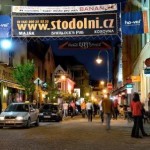A view of the Czech Republic countryside
Photo/submitted
By Victor Block
Part two of a two-part series
Last month, we visited the majestic city of Prague, one of the most magnificent and history-rich in all of Europe. Yet despite its many appeals, visitors to the Czech Republic who don’t venture outside the capital return home without experiencing all of that country’s many charms.
In a compact area about three-fourths the size of Virginia, the Czech Republic has a surprisingly varied landscape. Rolling farm fields and orchards lead to forested highlands that are overlooked by mountain ranges which virtually surround the small nation. The elevated basin of the interior is ringed by lower peaks.
Interspersed among these examples of Mother Nature’s handiwork are the country’s greatest assets, which are man-made. Hilltop castles, ornate cathedrals and imperial palaces dot the landscape and decorate cities and towns.
Charming villages scattered about the countryside echo the beauty of Prague but in smaller packages. Many of them surround an ancient central square and are set off by church steeples pointing toward the sky. In addition to similarities, each has its own unique charms.
The central square of tiny Telc could have been lifted from the pages of a Hans Christian Andersen story. The fairytale setting is lined by the decorative facades of arcade-fronted Renaissance townhouses painted a variety of pastel hues and set off by ornate gables and intricate designs and decorations.
It’s primarily what lies beneath the ground that makes Jihlava worth a visit. The story began in the 13th century when cellars were built under most houses in the town center for the storage of food, beer, wine and other items. Over several centuries, the storage areas were connected by tunnels, which stretched over 15 miles. People today may take a tour through sections of the catacombs, past exhibits that tell the story of the tunnels and how they were created.
Visitors to the Czech Republic seeking to explore its Jewish heritage often head for Trebic, about 100 miles from Prague. Among many vestiges of the Jewish aspect of the country’s history, that small city stands out.
The presence of Jewish people in present-day Trebic was first documented in 1338, but it wasn’t until the early 18th century that a ghetto was established. Today, it’s one of the best preserved ghettos in Europe and the only Jewish monument outside Israel that is included on the UNESCO World Heritage List.
The neighborhood encompasses 123 historic buildings, including two synagogues, a rabbi’s house, hospital and two schools. The Jewish cemetery nearby contains about 11,000 graves and almost 3,000 tombstones, some from the 1730s.
The scene is very different in the third largest city in the Czech Republic. Ostrava is home to about 300,000 residents, but is overlooked by sightseers, in part because of its reputation as a faded industrial and mining center. The upside is that it introduces visitors to a “real” city free of trappings of tourism, yet has attractions which are interesting and varied.
Not surprisingly, a castle tops the list. The Silesian Ostrava Castle was built in the 13th century as a border fortress, then rebuilt in 1534 as a Renaissance chateau. Along with its fortifications and lookout tower, the castle cellars contain a museum of witches and rather gruesome exhibits of torture instruments.
The Wallachian Open Air Museum just outside of Ostrava recreates traditional rural life by means of old buildings that have been moved to the site and newer replicas. Costumed interpreters and programs of music, dance and long-forgotten crafts add to the appeal. Completing the living history feel are farm animals and plots planted in crops that were grown in the area centuries ago.
Two other places, among several that made me glad I included Ostrava on my itinerary, also stand out. The Miniuni is a collection of close to three dozen miniscule models of famous European structures, built in perfect detail. My favorites were London’s Big Ben, the Leaning Tower of Pisa and the Eiffel Tower.
Strolling along Stodolni Street, it soon became clear why it’s called “the street that never sleeps.” More than 60 clubs, bars and restaurants are packed with mostly locals who eat, drink and make merry until the wee hours of the morning. Among names of pubs I checked out were the Wounded Goose and Blue Moose. I chose to skip the one called Hell.
“Taking the waters” at mineral spring spas has been an inherent part of life over centuries for people living in the present-day Czech Republic. Today, close to two dozen spa towns attract visitors in search of healing various ailments, or simply a relaxing experience. Among the most famous spas are Marianske Lazne, which is surrounded by nearly 100 natural springs, and Luhacovice Spa, which has been providing healing and hedonism for nearly 350 years.
It’s hard to beat the excitement and enjoyment of taking in the major attractions of Prague, as well as strolling through its hidden back streets and off-the-beaten-path neighborhoods. Yet visiting other history-rich towns throughout the Czech Republic that share similarities, yet which also have their own unique stories to tell, adds much to a visit to that enticing nation.
For more information about visiting the Czech Republic, log onto czechtourism.com.
Visit www.fiftyplusadvocate.com/archives/10593 to read the first part of this series.

Photo/submitted












